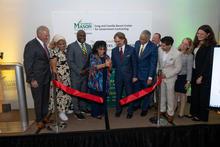- July 18, 2023
The need to strengthen supply chains is creating an opportunity for the revival of second sourcing, a method used until the 1990s to secure defense supply chains, write Olivia Letts and Jerry McGinn.
- December 12, 2023
What is the value of prototyping to the defense industrial base? In July of this year, we discussed the importance of prototyping for the Department of Defense to quickly and effectively innovate and field emerging technologies. This webinar will explore the importance of prototyping for the defense industrial base to include the different types of prototyping as well as various ways prototyping helps support the infrastructure and workforce.
- November 2, 2023
Current government acquisition rules are depriving DoD from consistently getting the benefits of the best industry talent, the best commercial capabilities, and quicker transition and deployment of needed capabilities. If the regulatory burden and negative incentives are not addressed head on, no amount of outreach or training will bring businesses back into the defense marketplace—or keep them from leaving. . . . In this decisive decade, acquisition regulations and policy must be streamlined to deliver outcomes and informed by data gathered through continued analysis of the shrinking defense industrial base from multiple perspectives—and most importantly, through difficult conversations with industry partners.
- November 2, 2023
This study sought to identify important trends in DoD’s supplier base and its rates of effective competition and market concentration, and importantly compare these trends with the rest of the federal government and its contractor base.
- August 23, 2023
While the origins of the Small Business Administration’s (SBA) Small Disadvantaged Business (SDB) contracting program and its prime contracting goals date to 1958, the history of the program is one of ebbs and flows. While the SDB appellation has applied at both the prime and subcontracting level, this paper will concern itself with prime contracting opportunities. However, before examining the data on the SDB program, it is important to understand the origins and evolutions of the program, as they provide the context necessary to assess the current performance of the program.
- September 5, 2023
George Mason University School of Business leaders, faculty, alumni, and friends gathered to celebrate the naming of the Greg and Camille Baroni Center for Government Contracting. The Baroni Center is the first university center in the nation to address the business, policy, and regulatory issues surrounding government contracting, a $700 billion industry unique to the Washington, D.C., region.
- August 17, 2023
The goal of the webinar is to discuss the challenges faced by the workforce to increase acquisition innovation and agility and explore approaches to modify incentives to achieve desired outcomes.
- July 27, 2023
Against the backdrop of the increasing hostilities and competition globally, this panel discussed the importance of prototyping for the Department of Defense to quickly and effectively innovate and field emerging technologies. The discussion also included lessons learned from recent prototyping activities as well as best practices for meeting future requirements.
- July 13, 2023
Tom Temin interviewed Jerry McGinn on ways to boost the surge capacity of the defense industrial base in the US.
- July 20, 2023
In a government acquisition context, the term “second sourcing” describes the practice of using at least two different suppliers to provide goods and services that are comparable or identical in form and/or function. Second sourcing was more commonly employed as a procurement method in the 1980s to introduce greater competition into the defense industrial base and cut costs for component parts, but it has become a relatively rare practice in modern defense procurement. This webinar examines second sourcing as a possible strategy within the defense acquisition toolkit to help accomplish this and other goals. Is it feasible, or even preferable, to revitalize second sourcing in a resource-constrained procurement environment geared toward single suppliers? If so, how do we do it best?




